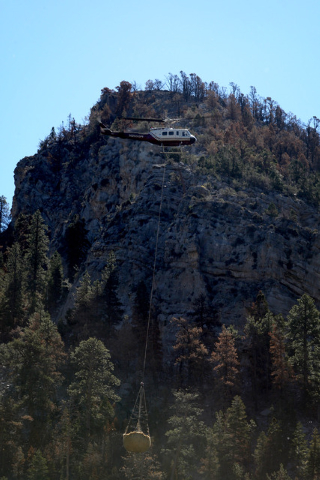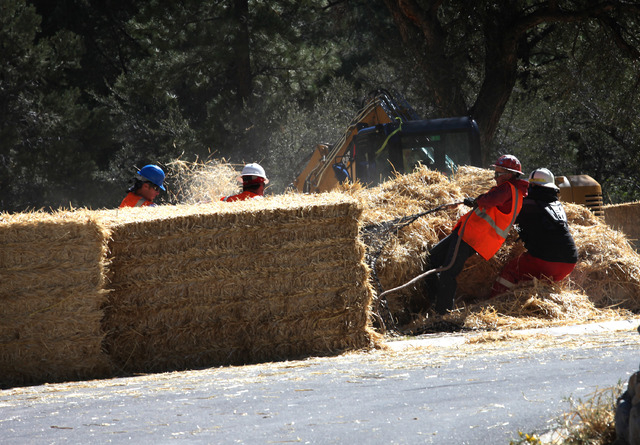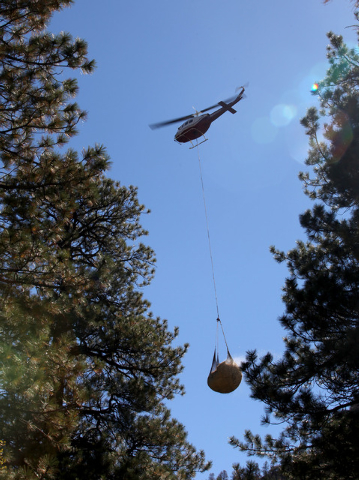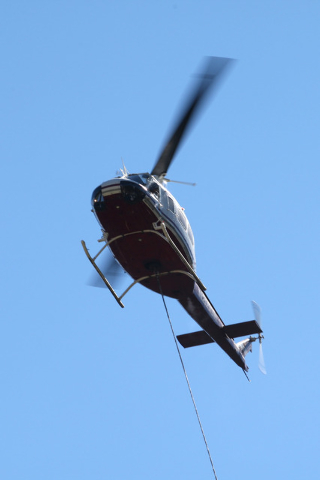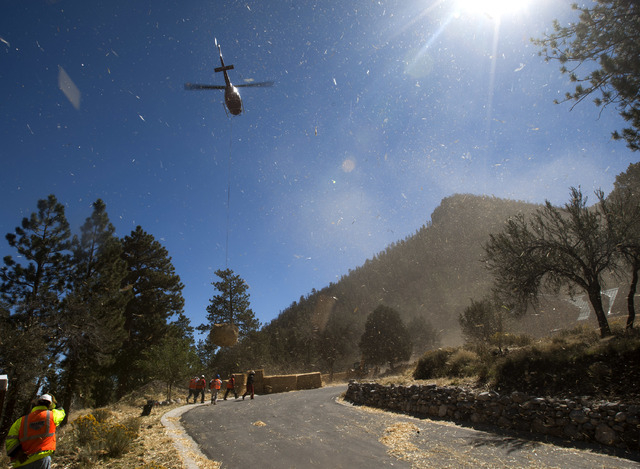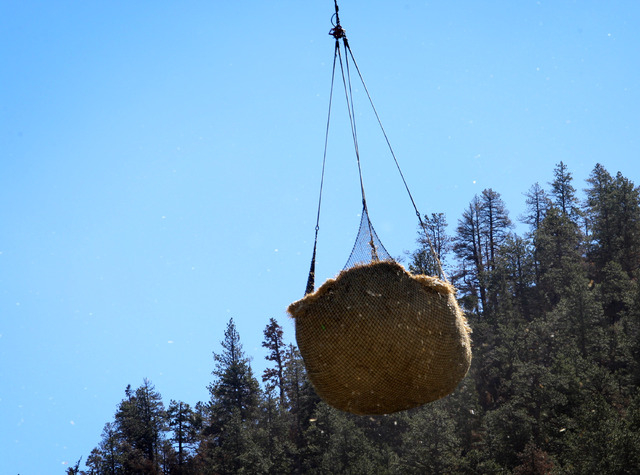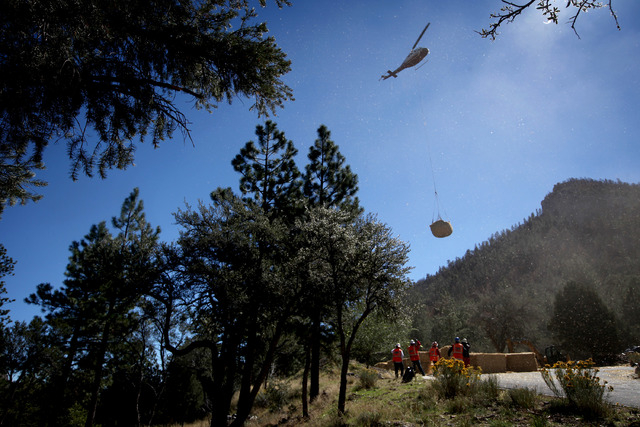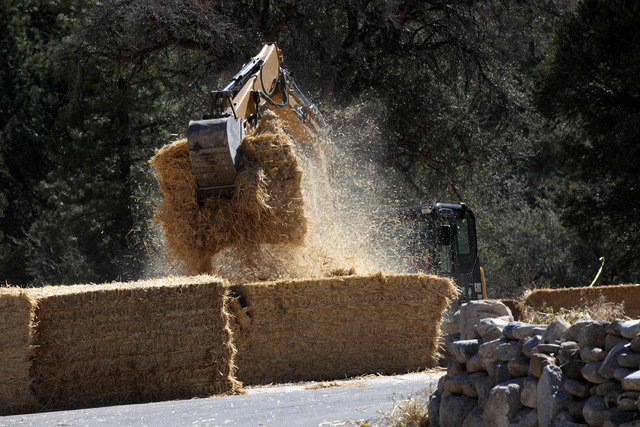Helimulching planned for Carpenter 1 area over next few days
A U.S. Forest Service employee adjusted his hard hat with one hand and held his radio in the other as tree branches bent under the force of helicopter blades whirring low in Kyle Canyon Sunday and 1,000 pounds of straw were dumped onto the Carpenter 1 Fire burn area.
For the next few days, this will be U.S. Forest Service employee Mike Papa’s world. Brought in from Alaska, he is part of the Burned Area Emergency Response (BAER) team that will work on cleanup and prevention following the summer’s nearly 28,000-acre wildfire.
A BAER team was mobilized to quickly assess the burn areas and decide what treatments would have the best effects for safety, property and natural resources. Helimulching— dropping straw on the ground from a helicopter to take the place of burned-off vegetation— is the project the team decided on first.
Mulching, according to the Forest Service, is designed to protect the ground and retain moisture in burned areas to help vegetation recover after a forest fire.
“It will nudge Mother Nature along in regrowth,” Papa said.
In Mount Charleston’s case, it entails dropping up to 1,300 pounds of straw at a time from a cargo net hanging from a helicopter.
Papa is the contracting officer representative for the mulching. He manages the day-to-day, or as he puts it, minute-to-minute operations. He coordinates everything between the contractor, the ground crews and the helicopter pilot to make sure safety and success are both achieved.
Papa, 33, has been in the forestry industry for eight years, four of them with the Forest Service. He usually works with timber sales in Alaska.
“It’s a good change of pace,” he said of the mulching. “BAER comes in and it’s a whirlwind.”
Each process of loading straw, flying it to its specified area and dropping it is called a “turn.” The Forest Service estimated that one turn can be accomplished in four to six minutes and they have 413 acres targeted.
It’s like clockwork. The baled straw is dumped in a secure area, where a ground crew and heavy machinery move in to “fluff” it up so it doesn’t fall on the ground in big clumps.
The helicopter approaches and all but two of the ground crew move to a safe zone.
The helicopter hovers over the straw so the cargo net— attached to the helicopter via a line 150 feet long— can be loaded with the straw.
The net is secured and the helicopter lifts up high so the net doesn’t hit the trees. It flies to the targeted area, releases half of the net so the straw can fall, and flies back for the next turn.
The project requires a skilled pilot, as wind in the canyons is unpredictable and the loading area only has a safe radius of about 50 feet. The helicopter is equipped with a “bubble window,” a half-sphere the pilot can lean into and see below.
The first area, called a unit, is directly above the Rainbow subdivision of homes in Kyle Canyon. By the end of the area’s mulching, the ground should be covered in a two-inch layer.
The straw is all certified to be weed-free and comes from Nevada and Utah. The contract is 10 days long, which should equate to about 45 flying hours. All in all, the price of the helimulching is $297,500. That’s under what was initially estimated, which will free up the extra funds for future BAER projects.
With recent flash flooding on the mountain and in the Las Vegas valley, the thought of more rain coming after they lay the straw is definitely on BAER’s radar, but not as a major worry.
Rain falling on a burn area is like using a fire hose to water your garden, Papa said, but having straw on top makes it more of a slow soak. The straw should take most of the water’s force, protecting the ground beneath. Even if some straw is moved downhill by rainfall, it won’t go far and will still have accomplished its task.
Along with rain, the Forest Service reported very small snow flurries Saturday night— the first of the season and so miniscule that the National Weather Service’s station in Kyle Canyon didn’t pick them up.
“It’s definitely possible,” a weather service spokesman said of the reported snow. It dropped to 34 degrees at the service’s highest-altitude station last night, and he acknowledged the chance that it could have happened higher up.
When snow falls and actually sticks in the winter, it shouldn’t be a problem for the straw. In contrast, it could actually help.
“It’s even more insulation for the ground while it recovers,” Papa said.
Forest Service officials are hopeful that the mulching done during this 10-day contract should remain effective for up to three years.
There are still nine other BAER treatments in the planning process to bolster the effort. Others will include clearing over 300 fallen trees, replacing water crossings and culverts, and installing water bars on trails.
BAER is a long process, with some treatments not scheduled to begin until spring. As for Papa, he’ll head back to Alaska as soon as this contract is over.
“You never know what will get thrown in your direction when it comes to Mother Nature,” Papa said.
In this case, it was straw.




